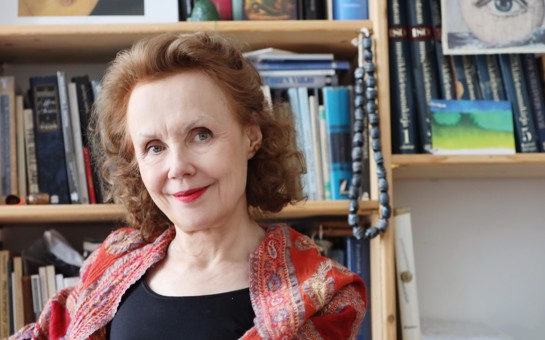- Kaija Saariaho
Dolce Tormento (2004)
- Chester Music Ltd (World)
Programme Note
With a duration of 5 to 6 minutes, Dolce Tormento is relatively short, but, as the title
suggests, full of „sweet torment“ in the character of the music. The text is from a sonnet of
Petrarch, reprinted below in the original as well as in various translations.
But there are also „sweet torments“ for the player! Kaija chose the piccolo for this piece
because we had not yet explored combining voice with this instrument. Both the high range
and limited resonance of the piccolo, as well as the nature of the Italian language posed new
challenges in developing a musical polyphony.
Of all her flute works this is the most freely notated, and interpretation is a further challenge,
especially for flutists not familiar with Kaija Saariaho’s musical language. I, of course, am
steeped in it, and since she was writing for me, writing rather quickly besides, the score is
more or less in „shorthand“, which she knew I’d be able to understand.
The usual Saariaho vocabulary is present: air sounds, controlled vibrato, glissandi, trills,
multiphonics, use of the voice and layers and transitions of all these. But there are no bar
lines, no tempo markings beyond „rit. A tempo“ (three times on the last page), no dynamics,
and a minimum of musical instructions: „Sempre dolce, espressivo, libero“ at the beginning,
then „piu agitato“, „molto rubato, espressivo“ and „calando“ toward the end. Traditional
notation is used for the rhythmic values of the pitches, but the way the notes are spread out
on the staff plus the way the phrases of the text are inserted without indication of duration
suggests more a „spacetime“ notation/interpretation than in her other scores.
Two further hints toward interpretation appear in the printed score under „Performance
Notes“: „One characteristic of this piece is an unstable playing between octaves, with the
desired sound vacillating freely between the octaves with frangile expression.“
„The text should always be recited between whispering and sotto voce, in such a way that the
given pitch resonates either as air or tone.“ -- K.S.
Camilla Hoitenga
S'amor non è, che dunque è quel ch' io sento?
Ma s'egli è amor, per Dio, che cosa e quale?
Se bona, ond'èl'effetto aspro mortale?
Se ria, ond'è si dolce ogni tormento?
S'a mia voglia ardo, ond'è 'l pianto e lamento?
S'a mal mio grado, il lamentar che vale?
O viva morte, o dilettoso male,
come puoi tanto in me, s'io no 'l consento?
E s'io 'l consento, a gran torto mi doglio.
Fra si contrari venti in frale barca
mi trovo in alto mar, senza governo,
si lieve di saver, d'error si carca
ch' i' medesmo non so quel ch' io mi voglio,
e tremo a mezza state, ardendo il verno.
Francesco Petrarca (1304-1374)
suggests, full of „sweet torment“ in the character of the music. The text is from a sonnet of
Petrarch, reprinted below in the original as well as in various translations.
But there are also „sweet torments“ for the player! Kaija chose the piccolo for this piece
because we had not yet explored combining voice with this instrument. Both the high range
and limited resonance of the piccolo, as well as the nature of the Italian language posed new
challenges in developing a musical polyphony.
Of all her flute works this is the most freely notated, and interpretation is a further challenge,
especially for flutists not familiar with Kaija Saariaho’s musical language. I, of course, am
steeped in it, and since she was writing for me, writing rather quickly besides, the score is
more or less in „shorthand“, which she knew I’d be able to understand.
The usual Saariaho vocabulary is present: air sounds, controlled vibrato, glissandi, trills,
multiphonics, use of the voice and layers and transitions of all these. But there are no bar
lines, no tempo markings beyond „rit. A tempo“ (three times on the last page), no dynamics,
and a minimum of musical instructions: „Sempre dolce, espressivo, libero“ at the beginning,
then „piu agitato“, „molto rubato, espressivo“ and „calando“ toward the end. Traditional
notation is used for the rhythmic values of the pitches, but the way the notes are spread out
on the staff plus the way the phrases of the text are inserted without indication of duration
suggests more a „spacetime“ notation/interpretation than in her other scores.
Two further hints toward interpretation appear in the printed score under „Performance
Notes“: „One characteristic of this piece is an unstable playing between octaves, with the
desired sound vacillating freely between the octaves with frangile expression.“
„The text should always be recited between whispering and sotto voce, in such a way that the
given pitch resonates either as air or tone.“ -- K.S.
Camilla Hoitenga
S'amor non è, che dunque è quel ch' io sento?
Ma s'egli è amor, per Dio, che cosa e quale?
Se bona, ond'èl'effetto aspro mortale?
Se ria, ond'è si dolce ogni tormento?
S'a mia voglia ardo, ond'è 'l pianto e lamento?
S'a mal mio grado, il lamentar che vale?
O viva morte, o dilettoso male,
come puoi tanto in me, s'io no 'l consento?
E s'io 'l consento, a gran torto mi doglio.
Fra si contrari venti in frale barca
mi trovo in alto mar, senza governo,
si lieve di saver, d'error si carca
ch' i' medesmo non so quel ch' io mi voglio,
e tremo a mezza state, ardendo il verno.
Francesco Petrarca (1304-1374)
Media
EIC, Ophèle
Discography
More Info

- Kaija Saariaho – Featured composer at ACHT BRÜCKEN Festival 2025
- 1st May 2025
- From May 9 to 18, ACHT BRÜCKEN festival Cologne will spotlight the works of portrait composer Kaija Saariaho.

 Located in the UK
Located in the UK
 Located in the USA
Located in the USA
 Located in Europe
Located in Europe